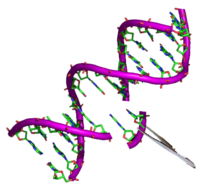
Photo from wikipedia
Abstract We studied the effects of temperature (180–260 °C) and catalytic methods (ultrafine grinding and phosphoric acid treatment) on the microwave-assisted hydrothermal carbonization of crop residues by taking rice straw, corn… Click to show full abstract
Abstract We studied the effects of temperature (180–260 °C) and catalytic methods (ultrafine grinding and phosphoric acid treatment) on the microwave-assisted hydrothermal carbonization of crop residues by taking rice straw, corn stover and rape stalk as the research materials. The physicochemical and structural properties of hydrochars and liquid products generated under different conditions were characterized. The results showed that with increasing temperature, the hydrochar yield of crop residues decreased from 62.97–83.09% to 42.73–57.38%; the liquid yield rose from 15.03–33.38% to 37.94–47.58%; and the gas yield increased from 1.88–4.92% to 4.68–10.90%. The liquid products were all acidic (pH = 2.53–4.40), and the NH4+–N and PO43–P concentrations respectively showed an upward trend and a downward trend with increasing temperature. Higher temperature led to enhanced carbonization degree, causing decreases in H/C and O/C atomic ratios but increases in higher heating value (HHV). Hydrochars prepared at 240 °C had the most intensified oxygenated functional groups, the largest specific surface area (5.5652–15.5058 m2/g), total pore volume (0.0403–0.1116 cm3/g) and mesopore volume (0.0395–0.1101 cm3/g), and the most carbon microspheres. However, temperature had a rather limited effect on the micropore volume of hydrochars derived from the three types of crop residues. Both ultrafine grinding and phosphoric acid catalysis could enhance hydrochar properties, with the latter being the more low-cost and efficient method. Hydrochars from ultrafine grinding crop residues had the highest peak strength of oxygenated functional groups, while those from phosphoric acid catalysis had higher fixed carbon (23.58–35.91%), C (45.03–65.50%) and HHV (17.45–27.18 MJ/kg), and lower ash content (4.21–15.67%), as well as the largest specific surface area (6.9140–15.5058 m2/g), total pore volume (0.0638–0.1116 cm3/g), micropore volume (0.0007–0.0015 cm3/g) and mesopore volume (0.0631–0.1101 cm3/g). Besides, crop residue type was also found to be an inherent factor determining hydrochar property.
Journal Title: Journal of Cleaner Production
Year Published: 2021
Link to full text (if available)
Share on Social Media: Sign Up to like & get
recommendations!